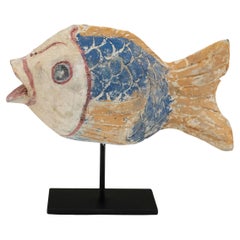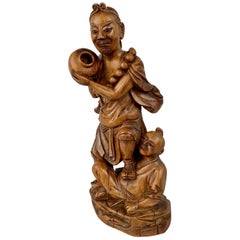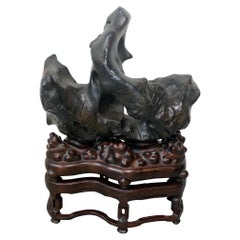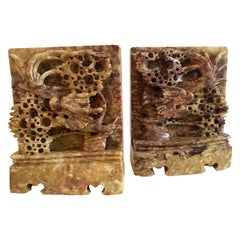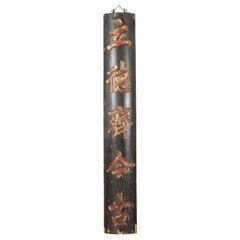Chinese Sculptures and Carvings
20th Century Chinese Export Chinese Sculptures and Carvings
Wood, Pine
1890s Chinoiserie Antique Chinese Sculptures and Carvings
Teak, Wood
19th Century Chinoiserie Antique Chinese Sculptures and Carvings
Stone
1950s Mid-Century Modern Vintage Chinese Sculptures and Carvings
Soapstone
Early 20th Century Qing Chinese Sculptures and Carvings
Porcelain
19th Century Antique Chinese Sculptures and Carvings
Wood
Late 19th Century Chinese Export Antique Chinese Sculptures and Carvings
Wood, Elm
19th Century Other Antique Chinese Sculptures and Carvings
Jade
20th Century Qing Chinese Sculptures and Carvings
Stone
20th Century Chinese Sculptures and Carvings
Wood
1920s Vintage Chinese Sculptures and Carvings
Fruitwood
Mid-20th Century Tang Chinese Sculptures and Carvings
Stone
Mid-20th Century Chinese Sculptures and Carvings
Wood
Early 20th Century Chinese Export Chinese Sculptures and Carvings
Bronze
20th Century Chinese Export Chinese Sculptures and Carvings
Coral
19th Century Qing Antique Chinese Sculptures and Carvings
Stone
19th Century Qing Antique Chinese Sculptures and Carvings
Jade
21st Century and Contemporary Chinese Sculptures and Carvings
Limestone
Early 19th Century Antique Chinese Sculptures and Carvings
Stone
21st Century and Contemporary Chinese Sculptures and Carvings
Stone
Late 19th Century Qing Antique Chinese Sculptures and Carvings
Stone
Early 20th Century Qing Chinese Sculptures and Carvings
Stone
16th Century Ming Antique Chinese Sculptures and Carvings
Wood
Early 20th Century Chinese Export Chinese Sculptures and Carvings
Wood
15th Century and Earlier Ming Antique Chinese Sculptures and Carvings
Terracotta
Mid-20th Century Chinese Export Chinese Sculptures and Carvings
Stone, Jade
Early 20th Century Chinese Sculptures and Carvings
Coral
Early 1900s Chinoiserie Antique Chinese Sculptures and Carvings
Jade
Early 20th Century Chinese Sculptures and Carvings
Sterling Silver
20th Century Chinese Sculptures and Carvings
Stone
19th Century Antique Chinese Sculptures and Carvings
Rosewood
Late 19th Century Tang Antique Chinese Sculptures and Carvings
Bronze
Mid-20th Century Chinese Sculptures and Carvings
Silk
Mid-19th Century Antique Chinese Sculptures and Carvings
Elm
Early 20th Century Qing Chinese Sculptures and Carvings
Jade
17th Century Ming Antique Chinese Sculptures and Carvings
Jade
20th Century Chinese Export Chinese Sculptures and Carvings
Pottery
18th Century Ming Antique Chinese Sculptures and Carvings
Limestone
15th Century and Earlier Antique Chinese Sculptures and Carvings
Ceramic, Terracotta
15th Century and Earlier Antique Chinese Sculptures and Carvings
Limestone
20th Century Chinese Export Chinese Sculptures and Carvings
Wood, Pine
21st Century and Contemporary International Style Chinese Sculptures and Carvings
Bronze
20th Century Qing Chinese Sculptures and Carvings
Shell
17th Century Qing Antique Chinese Sculptures and Carvings
Porcelain
Early 20th Century Chinese Sculptures and Carvings
Jade
Late 19th Century Archaistic Antique Chinese Sculptures and Carvings
Jade
Mid-20th Century Chinese Export Chinese Sculptures and Carvings
Rose Quartz
19th Century Antique Chinese Sculptures and Carvings
Rosewood
19th Century Qing Antique Chinese Sculptures and Carvings
Wood
19th Century Qing Antique Chinese Sculptures and Carvings
Wood
Late 19th Century Qing Antique Chinese Sculptures and Carvings
Soapstone
Late 20th Century Chinese Sculptures and Carvings
Marble
Early 20th Century Chinese Export Chinese Sculptures and Carvings
Soapstone
20th Century Chinese Export Chinese Sculptures and Carvings
Jade
19th Century Qing Antique Chinese Sculptures and Carvings
Jade
Mid-19th Century Qing Antique Chinese Sculptures and Carvings
Paint, Wood
1890s Antique Chinese Sculptures and Carvings
Wood
20th Century Qing Chinese Sculptures and Carvings
Soapstone
Late 19th Century Tang Antique Chinese Sculptures and Carvings
Wood
Early 20th Century Chinese Sculptures and Carvings
Porcelain
Read More
12 Calming Spaces Inspired by Japanese Design
From cherry-blossom-adorned walls paired with glamorous lighting to wood-paneled ceilings above checkerboard-patterned chairs, these 12 spaces seamlessly blend Eastern and Western aesthetics.
Rodrigo Rivero Lake’s Mexico City Showroom Is a Museum-Worthy Trove of Spanish Colonial and Asian Antiques
The dealer and curator has spent the past 50 years amassing a collection of exceptional art, furniture and architectural elements that trace the cultural influence of the Spanish empire from Europe to the Americas and beyond.
